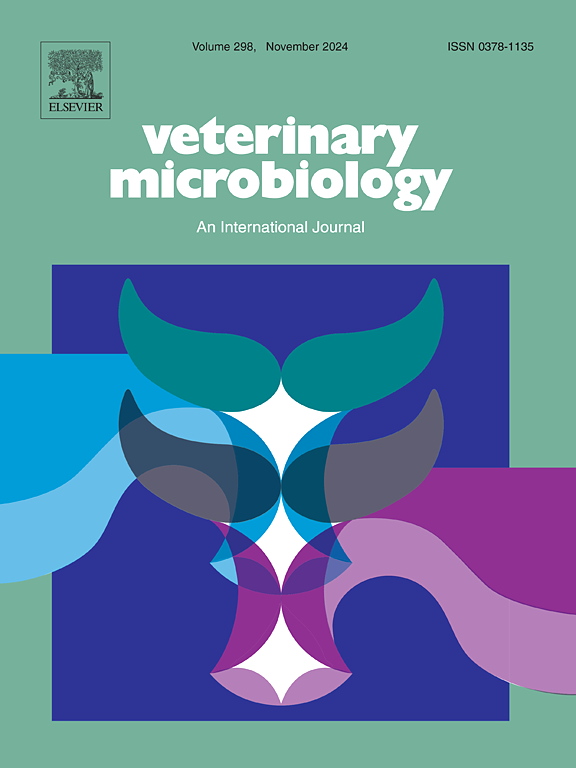抑制典型的Wnt/β-catenin通路干扰巨噬细胞作用抑制伪狂犬病毒增殖。
IF 2.4
2区 农林科学
Q3 MICROBIOLOGY
引用次数: 0
摘要
伪狂犬病毒(PRV)是一种高传染性病原体,给世界范围内的养猪业造成了重大的经济损失。更重要的是,自2019年首次分离出人类起源的PRV毒株以来,PRV正在成为一种潜在的“危及生命的人畜共患病”。先前我们发现典型的Wnt/β-catenin通路促进PRV增殖,但其潜在机制尚不清楚。本研究鉴定了Wnt抑制剂(Adavivint、CCT251545、FH535和iCRT14)的抗病毒活性。应用这些抑制剂可显著抑制PRV在不同细胞系中的增殖。其中,CCT251545抗prv活性最强,IC50值小于200 nM。我们的体内研究表明,用CCT251545治疗可显著降低病毒载量并保护PRV攻击的小鼠。进一步研究发现,CCT251545既不具有杀病毒作用,也不影响病毒吸附,主要干扰PRV生命周期的进入过程。通过fitc -葡聚糖摄取实验,我们发现CCT251545抑制巨噬细胞增多症。CCT251545也抑制了巨噬细胞增多症中重要的膜突起的形成。与此一致的是,敲除β-catenin可抑制PRV巨噬细胞增多和突起的形成。相反,LiCl处理显著刺激了PRV的进入和突起的形成。总之,这些发现表明,抑制Wnt/β-catenin通路可抑制PRV的巨噬细胞依赖性进入,从而为开发针对PRV的抗病毒药物提供了潜在的靶点。本文章由计算机程序翻译,如有差异,请以英文原文为准。
Inhibition of the canonical Wnt/β-catenin pathway interferes with macropinocytosis to suppress pseudorabies virus proliferation
Pseudorabies virus (PRV) is one of the highly contagious pathogens causing significant economic losses to the swine industry worldwide. More importantly, PRV is becoming a potential “life-threatening zoonosis” since the human-originated PRV strain was first isolated in 2019. Previously we found that the canonical Wnt/β-catenin pathway facilitates PRV proliferation, while the underlying mechanism remains unknown. In this study, the antiviral activities of the Wnt inhibitors (Adavivint, CCT251545, FH535, and iCRT14) were identified. Applying these inhibitors significantly inhibited PRV proliferation in different cell lines. Among them, CCT251545 presented the strongest anti-PRV activity with IC50 values less than 200 nM. Our in vivo studies showed that treatment with CCT251545 remarkedly decreased the viral loads and protected mice challenged with PRV. Further study found that CCT251545 neither had a virucidal effect nor affected viral adsorption while mainly interfering with the entry process of the PRV life cycle. Using the FITC-dextran uptake assay, we found that CCT251545 inhibited macropinocytosis. The formation of membrane protrusions, which is important for macropinocytosis, was also inhibited by CCT251545. Consistent with this, knockout of β-catenin suppressed the PRV macropinocytosis and the formation of protrusions. On the contrary, LiCl treatment significantly stimulated the protrusion formation and the PRV entry. Together, these findings suggest that suppression of the Wnt/β-catenin pathway inhibits the macropinocytosis-dependent entry of PRV, thereby providing potential targets for developing antiviral agents against PRV.
求助全文
通过发布文献求助,成功后即可免费获取论文全文。
去求助
来源期刊

Veterinary microbiology
农林科学-兽医学
CiteScore
5.90
自引率
6.10%
发文量
221
审稿时长
52 days
期刊介绍:
Veterinary Microbiology is concerned with microbial (bacterial, fungal, viral) diseases of domesticated vertebrate animals (livestock, companion animals, fur-bearing animals, game, poultry, fish) that supply food, other useful products or companionship. In addition, Microbial diseases of wild animals living in captivity, or as members of the feral fauna will also be considered if the infections are of interest because of their interrelation with humans (zoonoses) and/or domestic animals. Studies of antimicrobial resistance are also included, provided that the results represent a substantial advance in knowledge. Authors are strongly encouraged to read - prior to submission - the Editorials (''Scope or cope'' and ''Scope or cope II'') published previously in the journal. The Editors reserve the right to suggest submission to another journal for those papers which they feel would be more appropriate for consideration by that journal.
Original research papers of high quality and novelty on aspects of control, host response, molecular biology, pathogenesis, prevention, and treatment of microbial diseases of animals are published. Papers dealing primarily with immunology, epidemiology, molecular biology and antiviral or microbial agents will only be considered if they demonstrate a clear impact on a disease. Papers focusing solely on diagnostic techniques (such as another PCR protocol or ELISA) will not be published - focus should be on a microorganism and not on a particular technique. Papers only reporting microbial sequences, transcriptomics data, or proteomics data will not be considered unless the results represent a substantial advance in knowledge.
Drug trial papers will be considered if they have general application or significance. Papers on the identification of microorganisms will also be considered, but detailed taxonomic studies do not fall within the scope of the journal. Case reports will not be published, unless they have general application or contain novel aspects. Papers of geographically limited interest, which repeat what had been established elsewhere will not be considered. The readership of the journal is global.
 求助内容:
求助内容: 应助结果提醒方式:
应助结果提醒方式:


